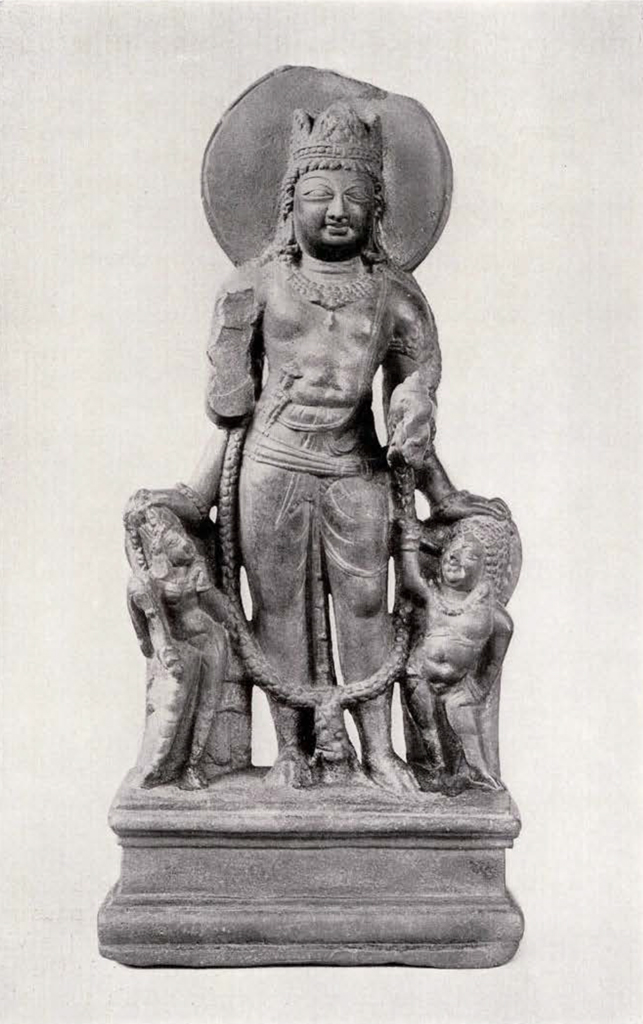The Museum of the University of Pennsylvania is the fortunate possessor of a very finely sculptured and well preserved statuette of Vishnu. The figure, which can be closely dated and placed, is of stone, eight and three quarter inches in height.
The deity, standing on a simple pedestal, wears a thin muslin dhoti and a kind of sash in which is stuck a straight handled dagger; he wears too a sacred thread of simple design, a crown with four purls of the usual northern type, the customary jewellery and a long flower garland (vanamala). The hair, in tight ringlets, emerges beneath the crown and falls on the shoulders. Of the four hands the two normal rest on the heads of a female cauri-bearer on the proper right and a male dwarf cauri-bearer on the proper left. The right upper hand is missing but almost certainly held an open lotus, the upper left holds the conch (sankha). Behind the head is a circular siras-cakra or nimbus. Beside the deity stand the two human attendants already mentioned, each with the fly whisk (cauri) in the right hand, and without attribute in the left. All the forms are vigorous and fleshy. The workmanship is accomplished and the general effect exceedingly elegant.

Museum Object Number: 29-64-241
There lingers some distant reminiscence of Gandhara in the pose, but the style is completely Indianised and the modelling is by no means superficial. The nearest stylistic analogies are to be found in the art of the Gupta period on the one hand, and in the early Nepalese bronzes on the other. The figure however can be more closely dated and placed than this. The pose and realistic modelling, the shape of the dagger1 and crown, the position of the hands on the heads of human attendants can all be exactly parallel in the Vishnu images and statuettes found at Avantipur in Kashmir, in the course of excavations at the Avantisvamin temple. This temple2 was built by Avantivarman (855-833 A. D.) “before his accessi on,” according to the Kashmir chronicle RAJATARANGINI, and thus about 850. It is extremely probable that the Pennsylvania figure was found on the same site. The same applies to a second, rather inferior, example in the collection; this figure is almost identical with the first in iconography, but both attendants are male. A Vishnu figure in the same style, but in brass inlaid with silver and copper, from Fatehpur, Kangra, is described by Vogel, J. Ph., in Archaeological Survey of India, Annual Report 1904-5, p. 109. The inscription is “of later date than the sixth century,” perhaps of the eighth or ninth. The only iconographical distinction from the figure in the Museum of the University of Pennsylvania is to be found in the representation of Prthvi, the Earth Goddess, rising from the pedestal between the feet of the deity. The only other similar images that have been found outside Kashmir come from Chamba and Lahul. In any case the figure may confidently be assigned to the middle of the ninth century.3
1 Apart from the group of images under discussion, I can recall no other example of an armed Vishnu.↪
2 The excavations are described by D. R. Sahni, “Excavations at Avantipur,” Archaeological Survey of India, Annual Report 1913-14. The finds are illustrated in the same report and in R. C. Kak’s “Handbook of the Archaeological and Numismatic Sections of the Sri Pratap Singh Museum, Srinagar,” Calcutta, 1923.↪
3 In “Rupam” No. 18, 1924, misled by the evident stylistic connection of the figure with the tradition of Gupta art, and by the excellence of its workmanship, and forgetting the Avantipur finds, I assigned an earlier date, which I am glad to have an opportunity to correct.↪

